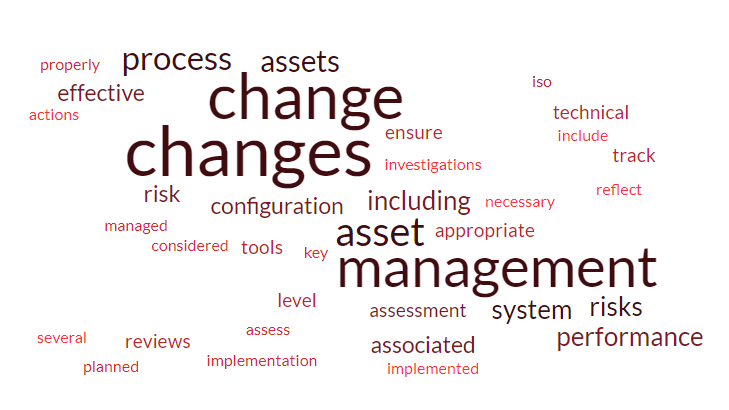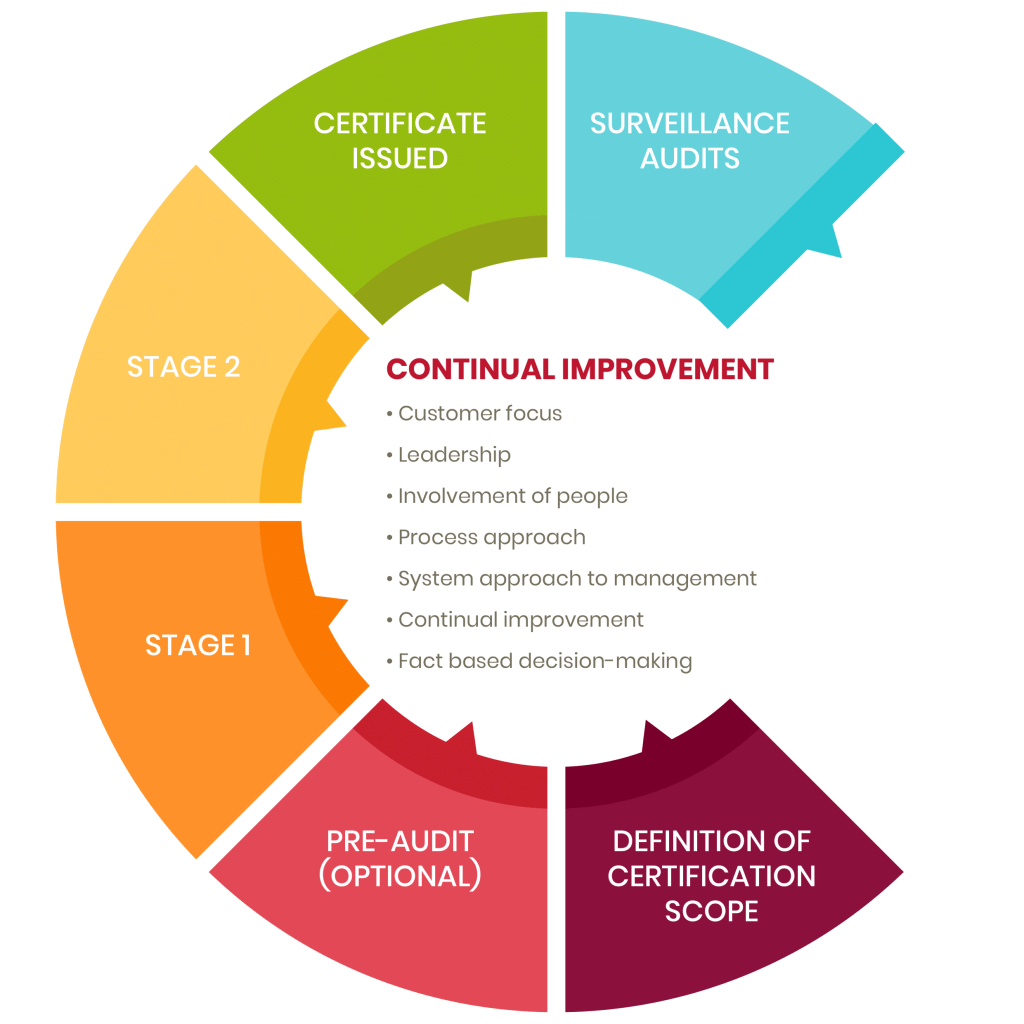In this article, we compare the most recent version of ISO 55001, published in 2024, with the previous version, published in 2014. The focus of this comparison is to explore the practical implications of these changes for organisations that are either currently certified as conforming to the requirements of ISO 55001:2014 or are considering conforming to the requirements of ISO 55001:2024.
We will be discussing:
• Minor wording changes to the previous requirements
• Requirements that have moved to different clauses in ISO 55001:2024
• Requirements that have been removed in ISO 55001:2024, and
• Additional requirements included in ISO 55001:2024
The differences between ISO 55001:2024 and ISO 55001:2014 are quite extensive, although many of them only have a minor impact on those organisations that have previously certified or aligned with the requirements of the 2014 version of the document.
Introduction
This article accompanies our earlier article comparing ISO 55000:2024 to ISO 55000:2014
As mentioned in that earlier article, ISO 55000:2024 outlines some high-level principles relating to Asset Management, but more importantly, contains the definitions of all the key terms used in ISO 55001:2024.
ISO 55001:2024 is the requirements document that specifies the criteria to be met if an organisation seeks to align with, or be certified as conforming to, the requirements of the standard.
In this article, we will only be comparing the 2024 version of ISO 55001 (that is, ISO 55001:2024) with its predecessor ISO 55001:2014. As mentioned previously, we compared the 2024 version of ISO 55000 with its predecessor ISO 55000:2014 in this article.
Minor wording changes
There are too many of these to list them all – and we are conscious of the need to avoid breaching ISO copyright in repeating them all here, however two examples of areas where there have been wording changes include:
Clause 4.1 – Understanding the organisation and its context
In Clause 4.1, the previous version of the standard stated:
The organization shall determine external and internal issues that are relevant to its purpose and that affect its ability to achieve the intended outcome(s) of its asset management system.
This has been amended in ISO 55001:2024 to read:
The organization shall determine external and internal issues that are relevant to its purpose and that affect its ability to achieve the intended result(s) of its asset management system.
As you can see, in this instance, the change in wording has very little or no impact on the intent behind this clause, and, in practice, can reasonably be ignored by those organisations that are already certified as conforming with the requirements of ISO 55001:2014.
Clause 4.2 – Understanding the needs and expectations of stakeholders
In Clause 4.2, the previous version of the standard stated, in part:
The organization shall determine:
a) the stakeholders that are relevant to the asset management system;
b) the requirements and expectations of these stakeholders with respect to asset management;
This has been amended in ISO 55001:2024 to read:
The organization shall determine:
a) the stakeholders that are relevant to the asset management system;
b) the relevant requirements of these stakeholders;
c) which of these requirements will be addressed through the asset management system;
The change in wording is subtle but is intended to emphasise that not all stakeholder requirements need to be addressed through the Asset Management system – an organisation can decide whether or not these needs will be addressed through the Asset Management System. In practice, this gives organisations some leeway in deciding the scope of the Asset Management system with respect to alignment or conformity with the standard (as permitted in Clause 4.3).
Requirements that have moved to different clauses in ISO 55001:2024
Requirements that have moved to different clauses in ISO 55001:2024
There have also been some welcome “cosmetic” adjustments to the standard to regroup requirements within clauses in a more logical manner.
Two examples of this include:
Clause 4.4 – Asset Management System
Clause 4.4 of ISO 55001:2014, included, in part, a requirement to develop a Strategic Asset Management Plan. This requirement has now been moved to a more logical location in a new Clause 6.2.1 in ISO 55001:2024, bearing in mind that the broad scope of Clause 6 in the standard relates to Planning.
Clause 8.2 – Management of Change
Clause 8.2 of ISO 55001:2014, included, in part, a requirement to assess the risks associated with any planned change prior to that change being made. This requirement has now been moved to its more logical location within the Planning clauses and a new Clause 6.3 in ISO 55001:2024 now contains this requirement, together with a requirement to ensure that where a need for changes has been identified, that these changes are carried out in a planned manner.
In practice, these changes should have little or no impact on those organisations that are already aligned with, or certified as conforming to, ISO 55001:2014.

Requirements that have been removed in ISO 55001:2024
There has clearly been a focus on simplifying, where possible, the contents of ISO 55001:2024 – partially by removing some areas of duplication that existed within ISO 55001:2014, but also by removing some more specific requirements. There has been some effort put in to try to make the requirements more “outcome” focused rather than specifying how those outcomes are to be achieved.
Most organisations will find that the requirements that have been removed are relatively minor in nature, and, in fact, will probably still be needed to be met by them in order to meet the outcomes expected from alignment or conformity with the updated standard.
Some examples of requirements that no longer exist in ISO 55001:2024 include the following:
Clause 4.2 – Understanding the needs and expectations of stakeholders
Clause 4.2 of ISO 55001:2014 included a requirement for the organisation to determine stakeholder requirements for recording and reporting on financial and non-financial information relevant to asset management. This specific requirement no longer exists, however, it can be assumed that this is now covered under the more general requirement to understand stakeholder requirements with respect to asset management.
Clause 5.1 – Leadership and Commitment
Clause 5.1 of ISO 55001:20124 no longer includes a requirement for top management to encourage cross-functional collaboration within the organisation. In practice, however, it is highly unlikely that an organisation’s asset management system will deliver its intended results without the existence of that cross-functional collaboration. So, once again, this change will have no significant impact for most organisations.
Clause 5.2 – Asset Management Policy
With respect to an organisation’s Asset Management Policy Clause 5.2 of ISO 55001:2024 no longer includes the following requirements:
• To be consistent with the organisational plan
• To be appropriate to the scale and nature of the organisation’s assets and operations
• To be implemented, periodically reviewed and, if necessary, updated.
The last of these is the most interesting, but once again, in practice, Clause 9.3, relating to the requirements for periodic Management Review of the Asset Management system, should capture the need to review and update the Asset Management Policy.
Additional Requirements in ISO 55001:2024
There are several major new requirements in ISO 55001:2024. These are as follows:
Clause 4.5 – Decision-Making Framework
This is a major new addition to ISO 55001 that covers ground that was not previously included in ISO 55001:2014.
In essence, it requires the organisation to have established and implemented a decision-making framework that is appropriate to the type, size and complexity of the organisation. At this level of detail, it is probably reasonable to assume that most reasonably mature organisations have structures for making most asset management related decisions that satisfy this high-level criterion.

However, the clause goes on to require the organisation to use this framework to, in essence, define what “value” means to it, and to define the decision-making “criteria” to be used to deliver that value. Unfortunately, the term “criteria” is not defined in ISO 55000:2024, so we are left to interpret what this means. Various dictionary definitions can lead us to surmise that “criteria” are the standards or requirements that must be met when making a decision. In practice, we suggest that “criteria” in asset management decision-making could be interpreted to mean that, to be accepted, a decision option must meet a qualitative criterion (e.g. an internal rate of return of greater than 15%) or that decisions are made in accordance with a defined process (e.g. investments >$1m require majority approval by the Board of Directors) or some combination of these. So, we can start to see that, to conform with the requirements of this clause, organisations must have defined decision-making processes for making different types of decisions.
The clause then goes on to further specify the factors that should be considered when defining the decision-making criteria. This includes factors such as the potential impact of the decision being made, the complexity of the decision, the time available to make the decision etc.
Finally, the standard requires the organisation to specify the appropriate processes, methods and tools for decision-making, based on the preceding considerations. Furthermore, the decision framework needs to consider, and presumably embrace, all decisions made throughout the asset life cycle.
All these requirements are sensible, and I believe that it is highly likely that larger, mature organisations will be able to demonstrate that they meet the requirements. However, additional time will be required by assessors to assess conformity with these requirements.
Clause 6.1 – Actions to Address Risks and Opportunities
This clause has been significantly restructured in ISO 55001:2024. In addition to introducing a clause (6.1.1) that covers the general requirements relating to planning for the Asset Management system (that includes requirements that were previously included in other clauses within ISO 55001:2014), the major difference is that planning for actions to address risks is now covered separately (in clause 6.1.2) to planning for actions to address opportunities (in clause 6.1.3). While many of the requirements are identical for both planning for risks and opportunities, it is clear that the authors of ISO 55001:2024 wanted to emphasise that effective management needs to address both opportunities and risks. While ISO 31000, the international standard for Risk Management, defines risk as being the “effect of uncertainty on objectives” and discusses the fact that this uncertainty can result in both positive and negative outcomes, the new emphasis in ISO 55001:2024 on planning for opportunities means that organisations should consider all opportunities – not just those arising from uncertainty.
In practice, in our experience, most organisations do plan to take advantage of opportunities as well to address risks – some more so than others – and so demonstrating compliance with these new requirements should not be difficult to achieve.
Clause 6.2.1 – Strategic Asset Management Plan (SAMP)
A new clause has been introduced in ISO 55001:2024 relating specifically to the SAMP. As discussed in our previous article discussing the changes in ISO 55000:2024 , the definition of a SAMP has been modified in this new version of the standard. Accordingly, Clause 6.2.1 contains different, and more explicit, requirements with respect to the SAMP. It also pulls together in one clause, those requirements relating to the SAMP that were previously spread across multiple clauses. This is a very welcome change that should make it a lot easier for people to understand both the intent, and required contents, for a SAMP.
One of the most important changes to the requirements for the SAMP is the explicit recognition that the contents of the SAMP can be spread across multiple documents. Once again, this is a very welcome change as, if all the required content was incorporated into a single document, that document would be extremely large, unwieldy, difficult to update and would, most likely, not be useful or used. This is something that we have been advocating to our clients for many years, and we are very happy to see that this is now officially permitted by the standard.
The general requirement for the SAMP now is that it “contains the strategies and approaches for decision-making and the implementation and alignment of asset management activities”. This is very different to the requirement under ISO 55001:2014, where the SAMP was required to specify how organizational objectives are converted into asset management objectives, the approach for developing asset management plans, and the role of the asset management system in supporting achievement of the asset management objectives. These previous requirements caused a lot of confusion and uncertainty amongst those wishing to align or certify as conforming to the requirements of ISO 55001, as a result of which, the SAMP was seen as being one of the most difficult documents to prepare.
Of specific note, the SAMP must now contain the asset management decision-making framework (discussed above), and as the SAMP must be retained as “documented information”, this means that the decision-making framework must also be formally documented, although it is allowed to be documented in many separate documents. For example, in most organisations, it is likely that the documentation relating to the process for capital investment decision-making will exist separately to the documentation relating to the process for making operational decisions, or maintenance scheduling decisions etc. For organisations seeking certification against ISO 55001:2024, we would suggest that if the decision-making framework is contained in multiple documents, there is value in having a single, summary document that outlines the types of asset management decisions that are made, and points to the other documents that contain the details of how those decisions are made and their associated decision criteria, tools and methods.
Other requirements for the SAMP make it quite clear that, at least in some areas, the SAMP really is a “plan” – that is it should contain, at least at a high level, initiatives and actions together with the timeframes for completion of those actions. Once again, this helps to make things much clearer than was the case with ISO 55001:2014.
Clause 6.3 – Planning of Changes
As mentioned earlier when discussing Management of Change, a new clause has been introduced in ISO 55001:2024 requiring changes to be carried out in a planned manner, and for the risks associated with changes that could impact on the achievement of Asset Management Objectives to be assessed prior to making those changes. The challenge for some organisations will be to be able to demonstrate (through documented evidence, ideally) that this is the case.
Clause 7.2 – Competence
A new requirement has been introduced into this clause for organisations to periodically undertake competence assessments to assess whether the required competences remain valid and are available. I suspect that many organisations can demonstrate, through performance reviews, training records etc., whether competences are available. However, meeting the requirement for periodic review of the competences that are required may require some organisations to implement a more formal process for doing this.
Clause 7.6 – Data and Information
The clause relating to data and information, as well as having been moved from Clause 7.5 in the previous version of the standard, has been substantially rewritten and been made more specific. Once again, in our view this is a significant improvement that permits greater clarity regarding the intent of this clause and will help organisations to more easily understand what is needed to demonstrate conformity with this clause.
Rather than, as was the case with ISO 55001:2014, there being a general requirement for an organisation to “determine its information requirements to support its assets, asset management, asset management system and the achievement of its organizational objectives”, the requirements are much more specific, and include, amongst other things, the need to:
• determine the data and information needed to support asset management
• establish data and information specifications
• develop a plan for the collection, integration, quality improvement, and sharing of data and information
Of these, the last bullet point above may, for some organisations, require the development of a new document covering these elements, but it is good to see that there is now an explicit requirement to focus on data quality improvement in ISO 55001:2024. This is something that was missing from the 2014 standard, and with the current trend towards using data analytics to support or drive decision-making, it is more important than ever that the data that is being used by these analytical tools is of adequate quality to support effective decision-making.
Clause 7.7 – Knowledge
This is another new clause and new area of focus in ISO 55001:2024. It recognises that knowledge is different from data and information, and that knowledge is an essential prerequisite for competence. And organisational competence is essential if the organisation is going to achieve its objectives.
The key requirements in this clause are for the organisation to determine the knowledge that is required to operate the asset management system, and then have processes in place for acquiring, retaining and utilising this knowledge. There are also requirements to periodically review the knowledge required, dispose of outdated knowledge, and acquire and utilise any new knowledge requirements.
I believe that one of the keys for being able to demonstrate conformity with these requirements will be to be able to demonstrate that the organisation has processes in place for capturing “tacit” knowledge – the knowledge that is in people’s heads – and turn it into “explicit” knowledge – knowledge that is documented and shared. This could be by means of having a “knowledge library”, and/or by having processes for capturing and sharing “lessons learned”, and/or by having regular meetings of “communities of practice”, amongst others. However, similar to the requirements relating to data and information, there should be appropriate quality assurance and quality improvement activities in place to ensure that the knowledge captured is up-to-date, accurate and relevant.
Clause 8.3 – Externally provided processes, products, technologies and services
Note that this has been renamed from the previously titled “Outsourcing” title that this clause was given in ISO 55001:2014. The major change in this clause is that it now embraces not only externally purchased services, but also eternally provided processes, technologies, products and activities that could impact on the achievement of asset management objectives. This significantly broadens the application of this clause. However, apart from the broader scope for this clause, the requirements remain fundamentally unchanged from those contained in ISO 55001:2014.
The major implication of this broader scope, I believe, is that organisations will need to be able to demonstrate that, in addition to having adequate controls in place for purchased services, they have appropriate specifications in place for products that they purchase that could impact on the achievement of asset management objectives. This would include, for example, any critical spare parts. They would also have to demonstrate that they have adequate controls in place to provide assurance that what was specified to be purchased is what was actually received and used.

Clause 9.3 – Management Review
There are only minor changes to this clause to include two additional requirements associated with Management Review. These are for the management review to explicitly include evaluation of the effectiveness of the decision-making framework as well as opportunities for continual improvement. These changes may require a change to the agenda for Management Review meetings but are unlikely to require significant additional effort to be able to demonstrate conformity with the requirements of this clause.
Clause 10.3 – Predictive Action
This has been renamed from “Preventive Action” in the 2014 version of the standard and the requirements in this clause have been significantly broadened and deepened. ISO 55001:2014 only required organisations to proactively identify potential failures in asset performance and evaluate the need to preventive action to address these. This requirement was comparatively easy to meet, as any form of preventive maintenance program would satisfy the requirements of this clause.
ISO 55001:2024 has now broadened this to include consideration of potential failures not only of asset performance, but of assets, asset management and the asset management system. Furthermore, there are more detailed requirements regarding the items to be considered when predicting and addressing potential failures in all these elements, including:
• the potential frequency and impact of those failures/non-conformities,
• the inputs required to determine the relationship between asset condition and the delivery of value (cost, performance, opportunity and risk), and
• the optimal intervention points to maximise value – e.g. those relating to maintenance, renewal, disposal of assets etc.
There is a significant increase in detail required to demonstrate conformity with these requirements compared with the previous requirements. This may create significant additional work for some organisations.
Increased focus on achieving desired results
A common criticism of ISO 55001:2014 was that the requirements focused too much on process, and not enough on outcomes or results. The only requirement for the Asset Management system to deliver the desired results was contained in one subclause within Clause 5.1 of ISO 55001:2014. This could lead to the somewhat absurd outcome that an organisation could potentially be certified as conforming to the requirements of ISO 55001:2014, with one minor non-conformance (failing to achieve the intended outcomes) even if the organisation’s Asset Management System was clearly not delivering the results that were desired or intended.
In ISO 55001:2024, this same subclause exists (Clause 5.1 (e)), but in addition to this, there have been other requirements added in various places throughout the standard requiring the organisation to not only take some action, but also to assess the effectiveness of the action(s) that it took in order to determine whether those actions led to the desired outcomes. For example, in Clause 7.3, relating to Awareness, there is now a requirement for the organisation to not only take action to ensure awareness of asset management within the organisation, but also to assess the effectiveness of the actions that it has taken. Similar requirements exist relating to Communication and the Decision Framework.
There is still, in my personal view, insufficient focus within the standard on ensuring that the Asset Management system actually delivers value (surely this deserves a major clause all by itself, rather than simply being one point in a subclause) but at least there does appear to be an increased focus on assessing the effectiveness of asset management activities within ISO 55001:2024.
Conclusion
The differences between ISO 55001:2014 and ISO 55001:2024 are significant. If you would like to assess the extent of your organisation’s conformity with the requirements of ISO 55001:2024, then please contact us to request a quotation.
Alternatively, if you would like to learn more about Asset Management or implementing an Asset Management system that conforms to the requirements of ISO 55001:2024, then you might consider attending one of the following training courses:
• Implementing an ISO 55001-compliant Management System
• Asset Management Master Class
• IAM Asset Management Foundation Award

